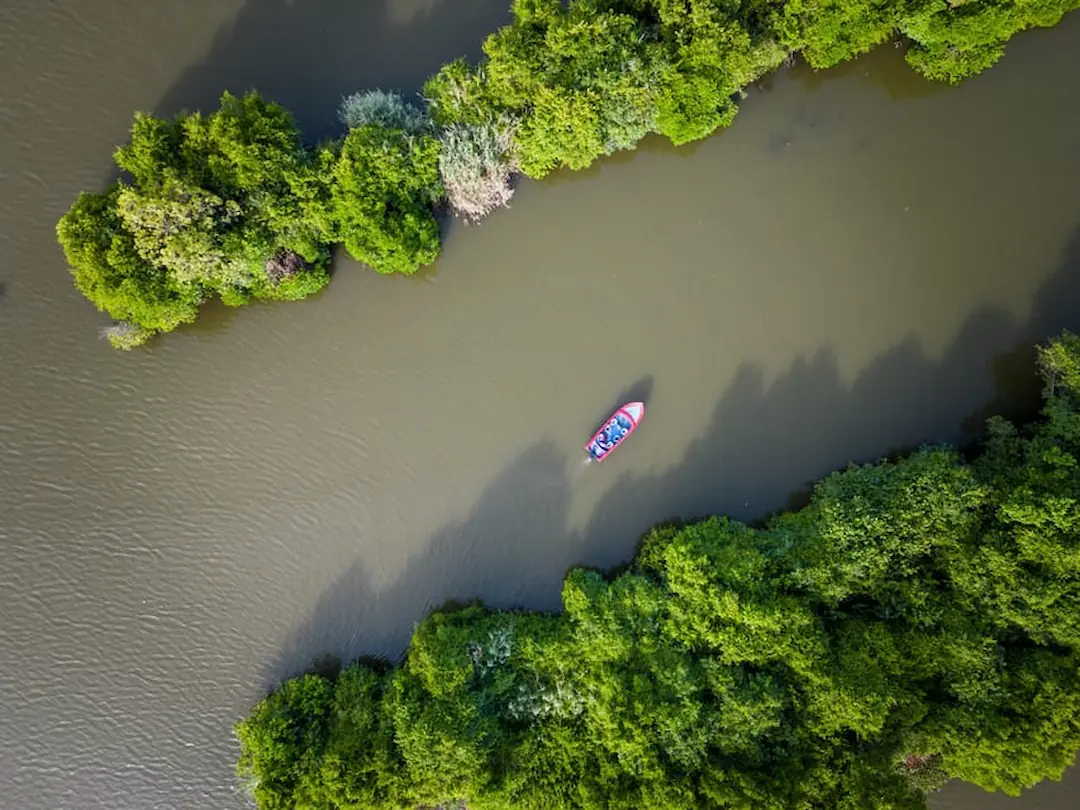Negombo Lagoon is a sprawling body of water near Negombo, nestled in southwestern Sri Lanka. Its waters come from a mix of small rivers and the historic Hamilton Canal, often referred to as the Dutch Canal. A thin waterway at the northern end connects the lagoon to the ocean, close to Negombo’s bustling urban center.
The area around the lagoon is home to a vibrant community rich with rice fields, coconut groves, and open grasslands. This land is primarily used for agriculture and fishing.
The lagoon is also known for its lush mangrove forests, which provide a haven for an array of waterbirds such as cormorants, herons, egrets, gulls, terns, and other species that thrive in these wetlands.
Towns like Negombo, Katunayake, and Seeduwa are nearby, forming part of the thriving community that surrounds this waterway. Fishing is a way of life here, with locals often catching lagoon crabs and prawns, which are highly sought after for their delicious flavor. Negombo City, not far from Colombo, has amazing hotels. If you are staying, you can enjoy boat tours. It’s a seafood lover’s paradise in Sri Lanka.
The Unique Features of Negombo Lagoon

Photo from getyourguide.co.uk
Negombo Lagoon, located on Sri Lanka’s western coast, is a sprawling 12-kilometer stretch of water that widens up to 3.75 kilometers at its broadest point. It’s a unique estuarine system deeply connected to the Indian Ocean and the expansive Muthurajawela Marsh.
These connections create a constantly shifting environment where saltwater from the ocean meets freshwater flowing in from rivers like Dandugam Oya and Ja-Ela. The result is an incredible mix of water types that supports a wide range of plant and animal life.
When you think about its depth, Negombo Lagoon might seem shallow, with an average depth of just 1.2 meters. But don’t let that fool you. The lagoon gets even shallower in some areas, with about 10% of it being less than 0.5 meters deep.
Yet, in other parts, it plunges to a maximum depth of 2.6 meters, creating varying habitats for aquatic life. These depth variations and the constant blending of freshwater and seawater make the lagoon a dynamic place, always changing and always fascinating.
Salinity and Water Conditions
One thing that stands out about Negombo Lagoon is its salinity. Depending on the season and rainfall, the salinity levels can swing from nearly freshwater levels to almost oceanic saltiness.
When the monsoons come through, they bring down the salinity as fresh rainwater floods in, but during the dry season, the salt levels spike as seawater flows in more freely from the ocean. This constant fluctuation keeps the lagoon’s ecosystem on its toes, adapting to the changing environment throughout the year.
The water temperature is another interesting factor. It’s pretty warm all year round, averaging between 29.8°C and 30.1°C, but you’ll notice some changes depending on the time of year.
In January, the water cools slightly, while the hottest temperatures hit from March to May. It’s not just steady heat, though. The temperature can change by 2 to 6 degrees within a single day, keeping things unpredictable for the creatures that live there.
Tides also play a big role in shaping life in the lagoon. The tidal range outside the inlet is about 30 centimeters, but things get more complicated inside. Due to something called “tidal choking,” where the narrow inlet slows down the tide, the tidal range decreases.
This effect is even more pronounced during spring tides, making the lagoon’s water flow slower and more controlled. These tidal shifts, along with the fluctuating salinity and temperature, create an environment that’s always in flux yet perfectly balanced for the plants and animals that depend on it.
The Biodiversity of Negombo Lagoon
One of the lagoon’s most remarkable features is its rich diversity of benthic invertebrate creatures, such as worms, crustaceans, and mollusks, that live on the bottom. In fact, 89 different species of these little critters have been recorded in the lagoon.
The mangrove forests surrounding the lagoon are another major contributor to its biodiversity. These mangroves cover about 3.5 square kilometers, mainly concentrated in narrow belts along the shoreline. They’re more than just trees.
They’re a lifeline for many species. The Rhizophoraceae family, which includes several types of mangrove trees, dominates the area, providing crucial habitats for fish, birds, and countless other organisms.
Then, you’ve got the seagrass beds, which are like underwater meadows covering about 22% of the lagoon’s area. These beds are not only a safe haven for small fish and invertebrates but also play a crucial role in growing fish production in the region. The seagrass provides shelter and food, supporting a complex web of life in the lagoon. It’s estimated that these beds contribute to producing around 150 kilograms of fish per hectare each year, making them vital for both the ecosystem and the local fishing industry.
Fishing and Ecological Productivity
The lagoon has long been a source of livelihood for local communities, and its productivity is impressive. Every year, around 1025 metric tons of fish are harvested from the lagoon, with shrimp making up 35% of that catch. Fishermen use various traditional methods, like trammel nets and stake-seine nets, to capture these valuable species.
Lagoon crabs and prawns are in especially high demand, both locally and beyond. These delicacies are prized for their taste, and their high market value adds even more importance to sustainable fishing practices in the lagoon. Without careful management, overfishing and habitat destruction could disrupt the delicate balance of this ecosystem, putting both the biodiversity and the livelihoods it supports at risk.
Once again, the seagrass beds play a starring role here, contributing to fish production and the health of the entire lagoon. With their ability to stabilize the seabed and provide food, they help sustain the wide variety of life that makes Negombo Lagoon such an essential ecological hotspot.
Environmental Challenges Facing Negombo Lagoon
Negombo Lagoon’s seagrass beds once thrived as vibrant underwater gardens, but they have taken a significant hit over the years. Between 1997 and 2004, these vital ecosystems experienced a 96% decline in their standing crops.
This decline was driven by unchecked development along the coast, with construction projects and human activity taking a heavy toll on the lagoon’s natural balance.
The rapid spread of filamentous algae, which grows thick and blocks sunlight, has choked the seagrass, preventing it from getting the light it needs to grow. Without sufficient light, the seagrass struggles to photosynthesize, leading to its slow and steady disappearance.
Seagrass beds provide shelter for small fish and invertebrates and help stabilize the lagoon’s floor, prevent erosion, and maintain water quality. As these beds decline, the lagoon becomes more vulnerable to environmental stressors, which could impact the wildlife and the local communities that depend on the lagoon for fishing and other activities.
Human Impact on the Ecosystem
Human activities are also a major issue in this ecosystem. Pollution, siltation, and nearshore development are among the lagoon’s biggest threats today. The inflow of pollutants from industrial waste to agricultural runoff has steadily degraded the water quality, making it harder for marine life to thrive.
Over the years, silt has also been building up, reducing the depth of the lagoon and impacting its delicate ecosystems. With reduced water flow and higher silt levels, the lagoon’s once-clear waters are becoming murkier, which disrupts the habitats of fish and invertebrates.
Another major factor is the rapid industrialization around the area.
The establishment of the Ekala industrial city and the Katunayake free trade zone has contributed to the degradation of the lagoon’s ecosystem. These industrial hubs are located close to the lagoon, and their waste, combined with the effects of urban sprawl, has only added to the pressure on this fragile environment.
Conservation Efforts and the Future of Negombo Lagoon
The lagoon is a complex ecosystem, and protecting it requires a holistic, ecosystem-based management approach. This means considering all the factors that affect the lagoon, from water quality to the health of its mangroves and seagrass beds. It’s not enough to just focus on one issue, like pollution or overfishing, because everything is interconnected. By adopting a broad strategy, conservationists can tackle multiple threats at once, giving the lagoon a better chance of recovery.
The lagoon serves as a crucial nursery and feeding ground for many species of fish and marine life, which makes its conservation all the more important. Young fish grow and find shelter in its waters before heading out to the open ocean.
The mangroves and seagrass beds are not only homes for countless species but also play a key role in maintaining the overall health of the marine ecosystem. Without these vital habitats, the marine food chain would be disrupted, impacting species both big and small. Protecting the lagoon isn’t just about saving one spot—it’s about safeguarding a key part of the larger marine environment.
The Role of Sustainable Fishing Practices
Fishing has always been a way of life around Negombo Lagoon, but it’s becoming increasingly clear that overfishing and habitat degradation are taking their toll. With the annual catch reaching 1025 metric tons, there’s no doubt that the lagoon is productive, but that kind of pressure can’t go on forever without consequences.
Overfishing can lead to dwindling fish populations, while destructive fishing methods can damage delicate habitats like seagrass beds and mangrove roots.
One of the solutions lies in promoting more responsible fishing methods that minimize harm to the ecosystem. This could involve regulating the types of nets used, limiting the size of catches, and designating protected areas within the lagoon where fishing is off-limits to allow populations to recover.
Additionally, educating local fishermen about the long-term benefits of sustainable practices is key. By preserving the lagoon’s biodiversity and fish stocks, these efforts will ensure that the lagoon can continue to support the community for generations to come. Sustainable fishing isn’t just a necessity.it’s a way to balance livelihoods with the environment’s health, ensuring a future where both can thrive.
